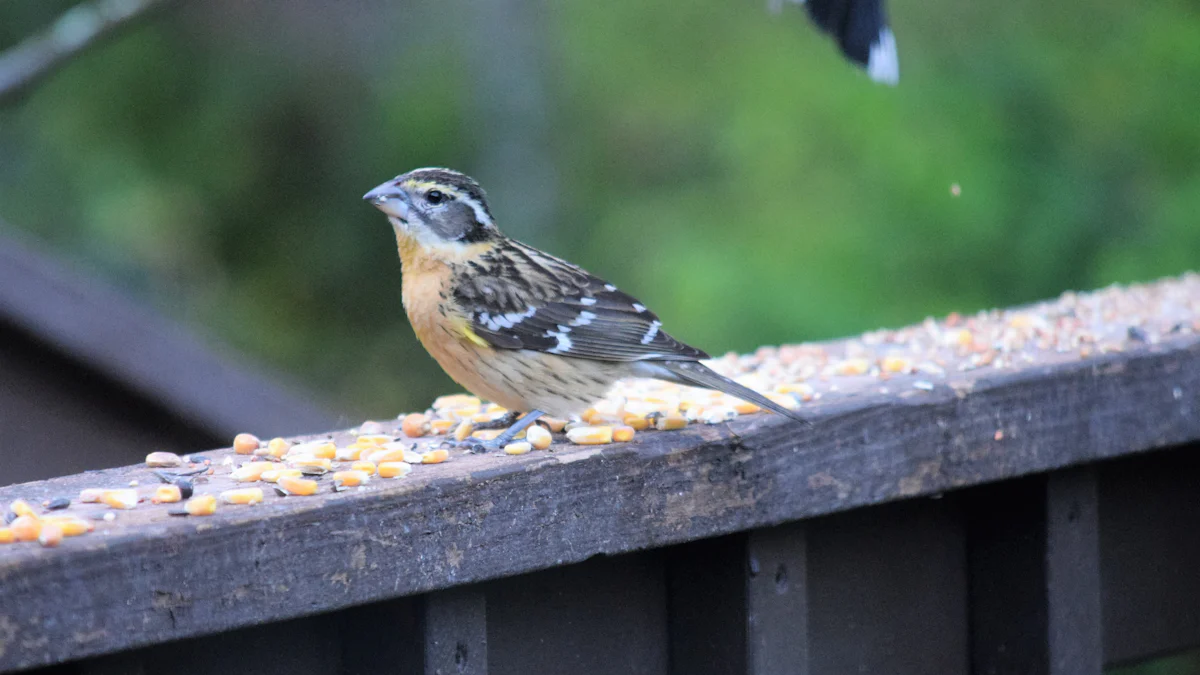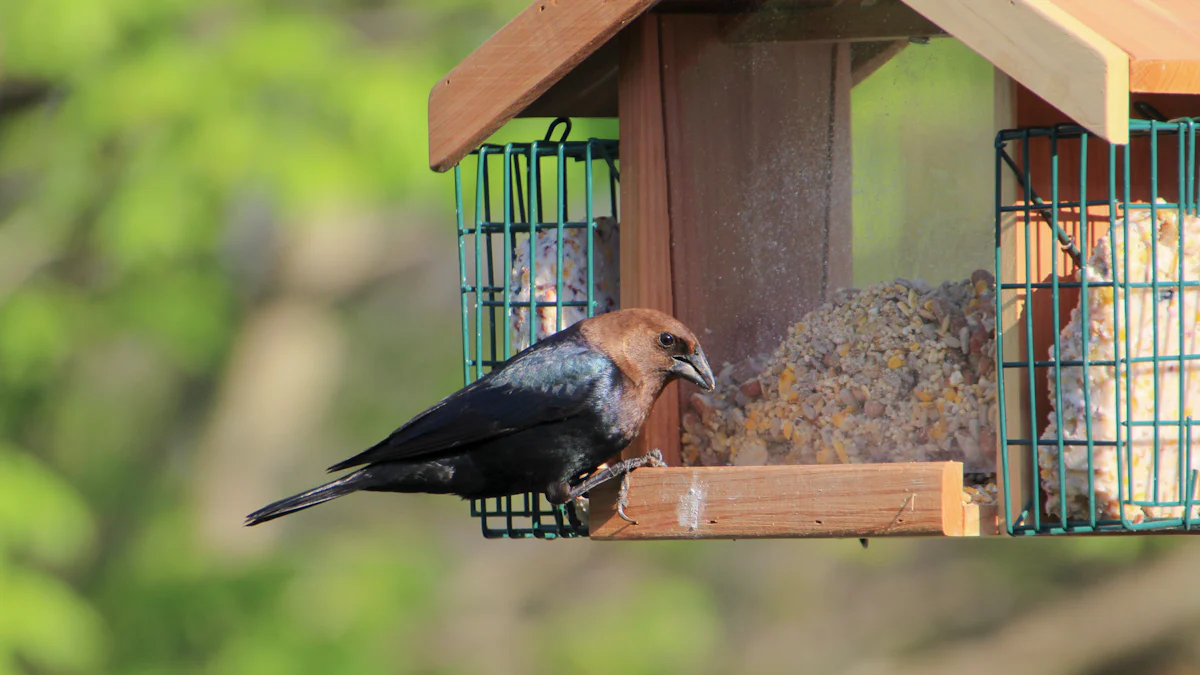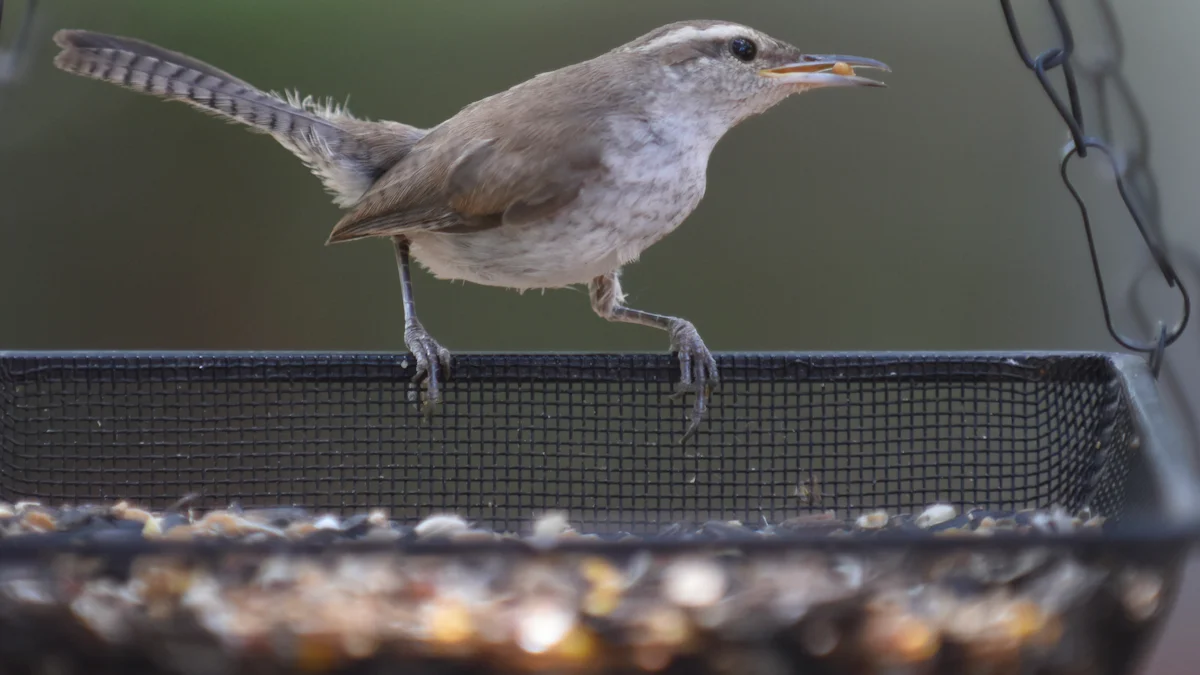
When it comes to feeding wild birds, you might wonder whether dried or live mealworms are the better choice. Birds generally prefer live mealworms because they are juicy and fresh, appealing to their natural hunting instincts. However, Dried Mealworms For Wild Birds offer convenience and ease of storage. Each type has its own set of advantages and disadvantages. While live mealworms attract more birds, dried ones can be a cost-effective option, especially if you’re feeding a large number of birds. Consider your specific needs and the ecological impact of feeding to make the best choice.
Key Takeaways
– Birds generally prefer live mealworms due to their freshness and movement, which stimulate natural hunting instincts.
– Dried mealworms are a cost-effective and convenient option, especially for feeding large numbers of birds, as they have a longer shelf life and require less maintenance.
– Both dried and live mealworms provide essential nutrients, but dried mealworms are higher in concentrated protein, while live mealworms offer hydration benefits.
– Proper storage is crucial: keep dried mealworms in an airtight container, while live mealworms need a ventilated environment in a cool place like a refrigerator.
– Feeding mealworms in moderation is important to avoid attracting unwanted predators and to maintain birds’ natural foraging behaviors.
– Consider seasonal needs: offer more mealworms during winter and nesting seasons to support birds’ increased nutritional requirements.
– Experiment with feeding methods, such as incorporating dried mealworms into homemade bird food, to enhance the feeding experience for both you and the birds.
Cost Comparison
When you’re deciding between dried and live mealworms for feeding wild birds, cost is a significant factor to consider. Let’s break down the expenses associated with each option.
Price of Dried Mealworms
Dried mealworms are generally more affordable than their live counterparts. You can expect to pay between
15and15 and
15and25 for a pound of dried mealworms, depending on where you purchase them. This amount contains several thousand mealworms, making it a cost-effective choice if you’re feeding a large number of birds. The convenience of dried mealworms also adds to their appeal, as they require less maintenance and are easier to store.
Price of Live Mealworms
Live mealworms, while often priced similarly to dried ones per tub, can become more expensive over time. They require specific storage conditions to keep them alive, which can add to the overall cost. Additionally, live mealworms tend to disappear quickly once offered to birds, meaning you’ll need to replenish your supply more frequently. This can make them a pricier option in the long run.
Long-term Cost Considerations
In the long term, dried mealworms may prove to be the more economical choice. Their longer shelf life and ease of storage mean you won’t have to worry about them spoiling or requiring special care. However, it’s important to consider the ecological impact of feeding wild birds. While providing food can support bird populations, it might also attract unwanted predators or alter natural foraging behaviors. To mitigate these effects, consider offering mealworms in moderation and alongside other natural food sources.
By weighing the costs and potential ecological impacts, you can make an informed decision that benefits both your budget and the wild birds you enjoy watching.
Nutritional Benefits

When choosing between dried and live mealworms for wild birds, understanding their nutritional benefits can help you make an informed decision. Both types offer valuable nutrients, but they have distinct profiles that might suit different needs.
Nutritional Profile of Dried Mealworms
Dried mealworms pack a punch when it comes to nutrition. They are high in protein, often exceeding 50%, which is essential for the growth and maintenance of bird feathers and muscles. These mealworms also contain essential fats and fiber, making them a well-rounded food source. The drying process concentrates these nutrients, offering a dense nutritional package. This makes Dried Mealworms For Wild Birds a convenient and nutritious option, especially when natural food sources are scarce.
Nutritional Profile of Live Mealworms
Live mealworms, on the other hand, provide a slightly different nutritional profile. While they also offer high levels of protein and fat, their moisture content adds an extra benefit. This moisture can be particularly valuable during hot weather or nesting seasons when birds need additional hydration. Live mealworms also contain amino acids, vitamins, and minerals that support overall bird health. Their natural movement can stimulate birds’ hunting instincts, encouraging more active feeding behavior.
Impact on Bird Health
Feeding mealworms, whether dried or live, can positively impact bird health. The high protein and fat content support energy levels and feather development. However, it’s crucial to consider the ecological impact of feeding wild birds. Offering mealworms in moderation can prevent attracting unwanted predators or altering birds’ natural foraging habits. You can balance this by providing a variety of food sources and ensuring that feeding does not disrupt local ecosystems.
By understanding these nutritional benefits, you can choose the right type of mealworm to support the health and well-being of the wild birds in your area.
Storage Requirements
When it comes to storing mealworms, whether dried or live, proper storage is key to maintaining their quality and ensuring they remain a nutritious option for wild birds.
Storing Dried Mealworms
Dried mealworms are quite easy to store. You should keep them in an airtight container to maintain their freshness. A cool, dry place is ideal, but for extended shelf life, consider storing them in the refrigerator. This prevents exposure to heat and moisture, which can lead to rancidity. By following these simple steps, you can ensure that your Dried Mealworms For Wild Birds remain a reliable food source for months.
Storing Live Mealworms
Live mealworms require a bit more attention. To keep them alive and healthy, store them in a cool, dry place. The refrigerator is often the best spot, as it slows down their metabolism and prolongs their life. Aim for a temperature range of 40-50°F (4-10°C). Use a container with ventilation holes and bedding material like wheat bran or oatmeal. This setup helps prevent suffocation and condensation. Regularly check on them to ensure they remain viable and replace bedding as needed.
Shelf Life Considerations
The shelf life of mealworms varies depending on whether they are dried or live. Dried mealworms generally have a longer shelf life, lasting several months when stored properly. Live mealworms, however, need more frequent monitoring and care to ensure they don’t spoil or die prematurely. Always practice stock rotation and moisture control to maintain freshness and viability.
Feeding wild birds can have ecological impacts. While mealworms provide essential nutrients, overfeeding might attract unwanted predators or alter birds’ natural foraging habits. To mitigate these effects, offer mealworms in moderation and alongside other natural food sources. This balanced approach supports bird health without disrupting local ecosystems.
Handling Differences
When it comes to handling mealworms, you’ll find that dried and live varieties offer different experiences. Understanding these differences can help you decide which type suits your needs best.
Handling Dried Mealworms
Dried mealworms are incredibly easy to handle. You don’t have to worry about them crawling away or spoiling. Simply store them in an airtight container, and they’re ready whenever you need them. This convenience makes them a popular choice for many bird enthusiasts. You can even get creative by incorporating them into homemade bird food recipes, like suet or birdseed cakes. This versatility adds to their appeal, especially if you enjoy experimenting with different feeding methods.
Handling Live Mealworms
Handling live mealworms might seem daunting at first, but you’ll get used to it quickly. Using gloves can make the process more comfortable, especially for beginners. Live mealworms require a bit more care, as you need to keep them in a suitable environment to ensure they stay alive. A cool, dry place like a refrigerator works well. Make sure to use a container with ventilation holes and bedding material to keep them healthy. Regularly check on them to ensure they remain viable. Despite the extra effort, many bird species prefer live mealworms due to their natural movement and freshness.
Ease of Use
In terms of ease of use, dried mealworms take the lead. They require minimal maintenance and are ready to use straight from the container. This makes them ideal for those who want a hassle-free feeding experience. Live mealworms, while more appealing to birds, demand more attention. You need to monitor their environment and replenish them more frequently. However, the effort can be rewarding, as birds often show a strong preference for live mealworms.
Feeding wild birds can impact the local ecosystem. While mealworms provide essential nutrients, overfeeding might attract unwanted predators or change birds’ natural foraging habits. To minimize these effects, offer mealworms in moderation and alongside other natural food sources. This balanced approach supports bird health without disrupting local ecosystems.
Bird Preferences

When it comes to feeding wild birds, understanding their preferences can make a big difference in attracting them to your backyard. Let’s explore how birds respond to dried and live mealworms.
Bird Attraction to Dried Mealworms
Dried mealworms offer convenience and affordability, making them a popular choice for many bird enthusiasts. However, not all birds find them equally appealing. Some species, like sparrows and chickadees, may nibble on dried mealworms, especially when other food sources are scarce. The ease of storing and handling dried mealworms makes them a practical option for those who want to provide a consistent food supply without much hassle. Yet, it’s important to note that while dried mealworms are nutritious, they might not attract as many birds as their live counterparts.
Bird Attraction to Live Mealworms
Live mealworms are often the star of the show when it comes to bird feeding. Their natural movement and freshness make them irresistible to many bird species. Birds like bluebirds and Carolina wrens show a strong preference for live mealworms, often choosing them over dried ones. This preference stems from the birds’ instinctual hunting behaviors, which are triggered by the movement of live mealworms. Although live mealworms require more maintenance, the reward of seeing a variety of birds flock to your feeder can be worth the effort.
Observations from Birdwatchers
Birdwatchers have shared valuable insights into the feeding habits of wild birds. Many have observed that birds tend to go for live mealworms first, followed by soaked mealworms, and finally dried mealworms. This hierarchy of preference highlights the appeal of live mealworms. However, birdwatchers also note that while live mealworms are more attractive, they require more care and attention. Dried mealworms, on the other hand, offer a convenient alternative for those who may not have the time or resources to maintain live mealworms.
Feeding wild birds can impact the local ecosystem. Overfeeding, especially with Dried Mealworms For Wild Birds, might attract unwanted predators or alter birds’ natural foraging habits. To minimize these effects, offer mealworms in moderation and alongside other natural food sources. This balanced approach supports bird health without disrupting local ecosystems.
Specific Use Cases
When deciding between dried and live mealworms for wild birds, it’s helpful to consider specific use cases. Each type of mealworm has its own advantages depending on the situation.
When to Use Dried Mealworms
Dried mealworms are a fantastic choice when convenience is your top priority. They store easily and last a long time, making them perfect for those who want a hassle-free feeding experience. If you’re planning to feed a large number of birds, dried mealworms can be a cost-effective option. You can keep them on hand without worrying about spoilage. During winter, when natural food sources are scarce, dried mealworms provide essential nutrients like protein and fat. This makes them a valuable food source for birds trying to survive harsh conditions. However, remember to offer them in moderation to avoid attracting unwanted predators or altering birds’ natural foraging habits.
When to Use Live Mealworms
Live mealworms shine when you want to attract a variety of bird species to your backyard. Their movement appeals to birds’ hunting instincts, making them irresistible to many species. If you enjoy watching birds up close, live mealworms can bring more activity to your feeders. They are especially beneficial during the spring when birds need extra protein for laying eggs and feeding their young. Offering live mealworms during this time can support birds’ protein-intensive activities. Keep in mind that live mealworms require more care and attention, but the reward of seeing diverse bird species can be worth the effort.
Seasonal Considerations
Feeding mealworms to wild birds can be beneficial all year round, but certain seasons call for specific considerations. During winter, both dried and live mealworms provide essential nutrients that help birds survive the cold months. In spring, increasing the frequency of feeding mealworms can support birds during nesting season. This is when they need extra protein for egg-laying and raising fledglings. Offering mealworms occasionally during these times can make a significant difference in birds’ well-being. Always balance feeding with the ecological impact, ensuring that your actions do not disrupt local ecosystems.
Feeding wild birds can have ecological consequences. Overfeeding, especially with Dried Mealworms For Wild Birds, might attract unwanted predators or change birds’ natural foraging habits. To minimize these effects, offer mealworms in moderation and alongside other natural food sources. This balanced approach supports bird health without disrupting local ecosystems.
In wrapping up, both dried and live mealworms offer unique benefits for wild birds. Dried Mealworms For Wild Birds provide a convenient, long-lasting, and cost-effective option, especially during winter when natural food is scarce. They are easy to store and handle, making them a practical choice for many bird enthusiasts. On the other hand, live mealworms attract a wider variety of birds due to their natural movement and freshness, which appeal to birds’ hunting instincts.
When deciding which type to use, consider your specific needs and circumstances. Think about the ecological impact of feeding wild birds. Overfeeding might attract unwanted predators or alter birds’ natural foraging habits. Offering mealworms in moderation and alongside other natural food sources can help maintain a balanced ecosystem. By weighing these factors, you can make an informed decision that benefits both your budget and the wild birds you enjoy watching.
FAQ
Why should you feed wild birds mealworms?
Mealworms provide essential nutrients like protein and fat, which are crucial for birds’ energy and feather development. They can be especially beneficial during winter when natural food sources are scarce. By offering mealworms, you help support the health and well-being of wild birds in your area.
How often should you feed mealworms to wild birds?
Feeding frequency depends on the season and bird activity. During nesting or cold months, you might offer mealworms more frequently to support birds’ increased nutritional needs. However, moderation is key. Overfeeding can attract unwanted predators and alter birds’ natural foraging habits.
What types of birdfeeders work best for mealworms?
Birdfeeders with trays or platforms are ideal for mealworms. These feeders allow birds easy access to the mealworms and prevent them from falling to the ground. You can also use specialized mealworm feeders with small openings to keep the mealworms contained.
How do you store mealworms properly?
For dried mealworms, store them in an airtight container in a cool, dry place. You can refrigerate them for extended freshness. Live mealworms need a bit more care. Keep them in a ventilated container with bedding material like wheat bran. Store them in a refrigerator at 40-50°F (4-10°C) to prolong their life.
How can you make dried mealworms more appealing to birds?
Birds might not take to dried mealworms immediately. You can moisten them slightly to make them more appealing. However, avoid leaving damp mealworms out for more than a day or two to prevent spoilage. Once one bird starts eating them, others will likely follow.
What are the ecological impacts of feeding mealworms to wild birds?
Feeding mealworms can impact local ecosystems. Overfeeding might attract predators or change birds’ natural foraging habits. To minimize these effects, offer mealworms in moderation and alongside other natural food sources. This balanced approach supports bird health without disrupting local ecosystems.
Can feeding mealworms attract unwanted predators?
Yes, overfeeding can attract predators like raccoons or larger birds. To reduce this risk, offer mealworms in moderation and use feeders that limit access to only smaller birds. Regularly clean feeding areas to avoid attracting pests.
Are there any specific bird species that prefer live mealworms?
Birds like bluebirds and Carolina wrens show a strong preference for live mealworms. Their natural movement appeals to these birds’ hunting instincts, making live mealworms an irresistible choice. Offering live mealworms can attract a wider variety of bird species to your backyard.
Is it necessary to feed mealworms year-round?
While mealworms provide valuable nutrients year-round, they are particularly beneficial during winter and nesting seasons. During these times, birds need extra energy and protein. Offering mealworms occasionally during these periods can make a significant difference in birds’ well-being.
What should you consider when deciding between dried and live mealworms?
Consider your specific needs and circumstances. Dried mealworms offer convenience and long shelf life, making them cost-effective. Live mealworms attract more birds due to their movement but require more care. Weigh these factors to make an informed decision that benefits both your budget and the wild birds you enjoy watching.


